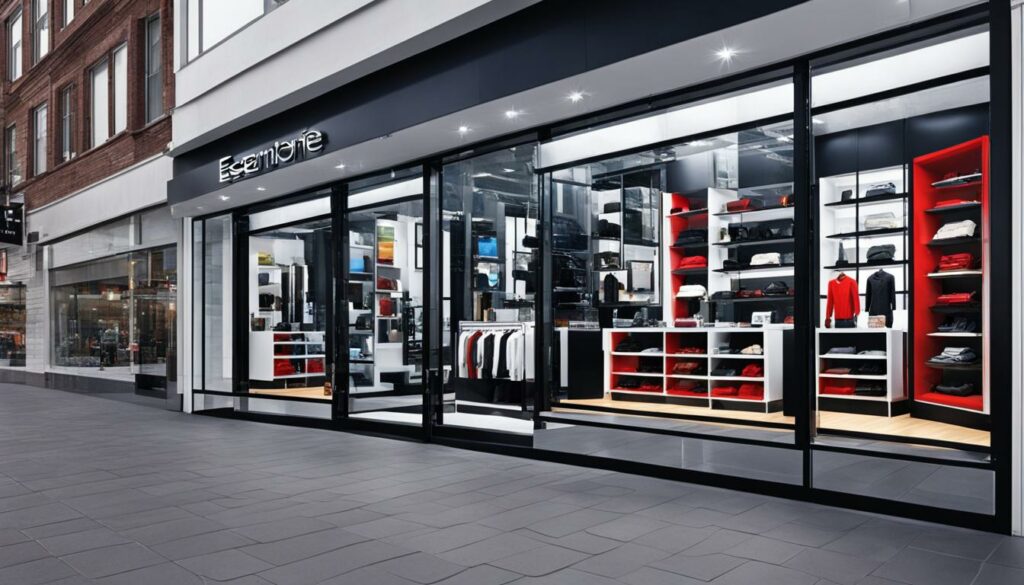A storefront in ecommerce refers to the presentation layer of an online store that interacts with online shoppers. It is the visual and functional first point of contact with customers on an ecommerce website. The storefront encompasses the frontend of the website, which includes elements such as fonts, colors, image sliders, search bars, product detail pages, and interactive features. The storefront is where marketing campaigns direct customers and plays a vital role in their decision to make a purchase. It is essential to have a high-quality and well-designed storefront that offers a great user experience, excellent web performance, omnichannel possibilities, personalized shopping experiences, high mobile conversion rates, appealing content, user-generated reviews, and added value to stand out in the competitive ecommerce market.
Key Takeaways:
- A storefront in ecommerce is the presentation layer of an online store, interacting with online shoppers.
- The storefront encompasses the frontend of the website, including design, layout, and interactive features.
- A well-designed and optimized storefront is crucial for attracting and engaging customers, driving conversions and sales.
- Investing in a successful storefront includes creating a user-friendly interface, optimizing web performance, personalizing the shopping experience, and updating based on customer feedback and market trends.
- Understanding customer behavior and aligning the storefront design with their preferences is key to increasing engagement and driving conversions.
Definition of Storefront in Ecommerce
In the context of ecommerce, a storefront refers to the frontend or presentation layer of an online store. It is the part of the ecommerce website that online shoppers see and interact with. The storefront encompasses all the visual and functional elements that create the online shopping experience, such as the design, layout, navigation menus, product pages, and interactive features. It is responsible for providing a seamless and engaging user experience, attracting and enticing customers with the brand’s offerings, and ultimately driving sales. A well-designed and optimized storefront can significantly impact the success of an ecommerce business.
To better understand the concept of a storefront in ecommerce, imagine walking into a physical retail store. The storefront would be the area that captures your attention, displays enticing products, and gives you a glimpse of what the store has to offer. Similarly, in the digital realm, the ecommerce storefront serves as the virtual storefront, creating the first impression and setting the tone for the entire shopping experience.
Just like a physical storefront, the ecommerce storefront plays a crucial role in attracting and retaining customers. It sets the brand image and creates a connection with the target audience. By providing a visually appealing and user-friendly interface, the storefront encourages customers to explore further, browse through products, and make purchases. It is the gateway to a successful ecommerce journey.

“The ecommerce storefront is like the face of a brand in the digital world. It needs to be captivating, intuitive, and representative of the brand’s values and offerings.”
Creating an effective storefront requires careful consideration of various factors, including the target audience, industry trends, and user expectations. It entails designing a visually appealing layout that reflects the brand identity, utilizing intuitive navigation menus for easy browsing, optimizing product pages for detailed and enticing displays, and integrating interactive features to enhance the overall shopping experience.
In the next section, we will explore the importance of the ecommerce storefront and how it contributes to the success of an ecommerce business.
Importance of Storefront in Ecommerce
The storefront plays a crucial role in the success of an ecommerce business. It serves as the first impression for online shoppers and has a significant impact on their purchasing decisions. A well-designed and user-friendly storefront can provide a great user experience, increase customer engagement, build trust, and ultimately drive conversions and sales.
An appealing and functional storefront helps establish the brand identity and positioning in the market. It sets a business apart from its competitors, providing a competitive edge and enhancing overall customer satisfaction and loyalty. Investing in creating a successful storefront is essential for maximizing the potential of an ecommerce business.
Strategies to Improve Storefront in Ecommerce
In order to create a successful storefront in ecommerce, there are several strategies and best practices that can be implemented to optimize the user experience and drive conversions. By focusing on these key features of an effective storefront in ecommerce, businesses can enhance their online presence and stand out in the competitive market.
- Create a user-friendly and intuitive interface: A simple and visually appealing storefront design with easy navigation and consistent branding elements can provide a seamless user experience. By prioritizing usability, customers can easily find what they’re looking for, leading to increased engagement and higher conversion rates.
- Optimize web performance: Page loading times and mobile responsiveness play a crucial role in ensuring a frustration-free shopping experience. By improving website speed and responsiveness, businesses can reduce bounce rates and improve overall customer satisfaction.
- Personalize the shopping experience: Tailored recommendations, special offers, and targeted promotions can help businesses engage customers and encourage them to make a purchase. By understanding customer preferences and behavior, businesses can provide relevant content and offers, increasing the likelihood of conversion.
- Incorporate high-quality visuals: Eye-catching images and videos can captivate customers and showcase products in the best light. By investing in high-quality visual content, businesses can enhance the appeal of their storefront and make a memorable impression on customers.
- Utilize user-generated reviews: Customer reviews provide social proof and build trust among potential buyers. By incorporating user-generated reviews into the storefront, businesses can establish credibility and encourage customers to make informed purchasing decisions.
- Highlight your unique value proposition: Compelling and appealing content can effectively communicate the unique value that a business offers. By showcasing the benefits and features of products, businesses can differentiate themselves from competitors and attract customers.
- Continuously optimize and update: Regularly monitoring customer feedback and market trends is essential for maintaining a competitive edge. By analyzing user data and staying up to date with evolving customer preferences, businesses can adapt their storefront design and functionalities to meet the changing demands of the market.
By implementing these strategies and continuously optimizing the storefront design in ecommerce, businesses can create a compelling online shopping experience that drives customer engagement, increases conversions, and ultimately leads to long-term success.

Customer Behavior and Storefront in Ecommerce
Understanding customer behavior is critical for optimizing the storefront in ecommerce. By analyzing customer data, such as browsing history, purchase behavior, and demographic information, businesses can gain valuable insights into their target audience. This information helps in personalizing the shopping experience and offering relevant recommendations that align with customer preferences and expectations.
One factor to consider is mobile usage. With the increasing number of people shopping on mobile devices, it is essential to ensure that the storefront is mobile-friendly and responsive. This allows for a seamless browsing and purchasing experience, regardless of the device being used.
Social proof also plays a significant role in customer behavior. Incorporating customer reviews and ratings on the storefront can build trust and influence purchasing decisions. Additionally, offering user-generated content and testimonials can further enhance the credibility of the brand and products.
Another consideration is ease of use. A well-designed storefront with intuitive navigation and clear product descriptions can significantly impact the customer experience. By providing a user-friendly interface, businesses can create a frictionless journey for customers, leading to increased engagement and conversions.
Ultimately, aligning the storefront with customer behavior is crucial for a successful ecommerce business. By understanding customer preferences, optimizing the storefront design, and providing a seamless user experience, businesses can build trust, increase engagement, and drive conversions.
| Factors to Consider for Customer Behavior and Storefront Optimization | Importance |
|---|---|
| Mobile Usage | High |
| Social Proof (Reviews, Ratings, Testimonials) | Medium |
| Ease of Use (Navigation, Product Descriptions) | High |
Challenges and Considerations in Storefront Design in Ecommerce
Designing a successful storefront in ecommerce presents unique challenges and requires careful considerations. One of the primary challenges is striking the right balance between aesthetics and functionality. While it is crucial to have an attractive design that captures the attention of online shoppers, it should not come at the expense of usability and user experience. A visually appealing storefront must also provide intuitive navigation and seamless functionality to ensure a smooth and enjoyable shopping experience.
Another challenge in storefront design is the need to keep up with the rapidly evolving technology and design trends in the ecommerce industry. To stay ahead of the competition, ecommerce businesses should continuously update and optimize their storefronts to meet the changing expectations of customers and the evolving demands of the market. By embracing new technologies and staying current with design trends, businesses can provide a fresh and engaging storefront that resonates with their target audience.
Moreover, there are several important considerations to keep in mind when designing a storefront in ecommerce. Mobile-friendliness and responsiveness are critical factors, as a significant portion of online shoppers now browse and make purchases through their mobile devices. Ensuring compatibility across different devices and browsers is also essential to reach a wider audience and provide a consistent experience for all users.
Additionally, accessibility is a crucial consideration in storefront design. Businesses should aim to create a storefront that is accessible for users with disabilities, ensuring that everyone can easily navigate and interact with the website. Seamless integration with other ecommerce platforms and systems is another consideration that enables businesses to streamline their operations and provide a seamless end-to-end shopping experience for their customers.
In order to address these challenges and considerations, it is vital to conduct user testing and collect feedback. By soliciting input from users and analyzing their experiences with the storefront, businesses can identify any usability issues and make the necessary improvements to create a smooth and frictionless shopping experience. By addressing these challenges and considerations head-on, ecommerce businesses can design storefronts that not only capture the attention of online shoppers but also provide an exceptional user experience that drives conversions and builds customer loyalty.
FAQ
What is a storefront in ecommerce?
A storefront in ecommerce refers to the presentation layer of an online store that interacts with online shoppers. It is the visual and functional first point of contact with customers on an ecommerce website.
What does storefront encompass in ecommerce?
The storefront encompasses the frontend of the website, which includes elements such as fonts, colors, image sliders, search bars, product detail pages, and interactive features.
Why is a storefront important in ecommerce?
The storefront plays a vital role in customers’ decision to make a purchase. It is essential to have a high-quality and well-designed storefront that offers a great user experience, excellent web performance, personalized shopping experiences, and added value to stand out in the competitive ecommerce market.
How can I improve my storefront in ecommerce?
To improve your storefront in ecommerce, you can focus on creating a user-friendly interface, optimizing web performance, personalizing the shopping experience, using high-quality images and videos, showcasing user-generated reviews, and continuously optimizing and updating based on customer feedback and market trends.
How does customer behavior affect the storefront in ecommerce?
Customer behavior plays a significant role in the success of a storefront in ecommerce. Understanding customer preferences, needs, and buying patterns can help optimize the storefront to cater to the target audience effectively and increase engagement, trust, and conversions.
What are the challenges and considerations in storefront design in ecommerce?
Challenges in storefront design in ecommerce include maintaining a balance between aesthetics and functionality, keeping up with evolving technology and design trends, and considerations such as mobile-friendliness, compatibility, accessibility, and integration with other ecommerce platforms and systems.
